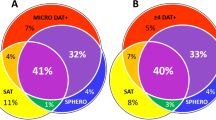Abstract
A Sephadex gel filtration technique was compared with a radial immunodiffusion (RID) method for the assay of serum haptoglobin in the dog. Administration for a haemolytic agent (acetylphenylhydrazine) to dogs resulted in reduced serum haptoglobin but without a significant change in red cell indices. It is suggested that the assay of serum haptoglobin in the dog may be of value in detecting low grade haemolysis when other criteria fail. After standardising the assay using the gel filtration technique, a number of samples can be screened simultaneously using RID thus enabling routine clinical laboratory monitoring for haemolysis. The clinical value of serum haptoglobin assay in the diagnosis of canine haemolytic anaemia is discussed.
Similar content being viewed by others
References
Allen B, Archer RK (1971) Haptoglobins in the horse. Vet Rec 89:106–109
Alper CA, Peters JH, Birtch AG, Gardner FH (1965) Haptoglobin synthesis. I. In vitro studies on the production of haptoglobin, fibrinogen and gamma-globulin by the canine liver. J Clin Invest 44:574–581
Anderson MN, Mouritzen CV, Gabrielli ER (1966) Mechanisms of plasma haemoglobin clearance after acute haemolysis in dogs. Ann Surg 164:905–912
Batchelor J, Fuller J, Woodman DD (1989) A simple method for the measurement of the haemoglobin binding capacity of canine haptoglobin. Lab Anim 23:365–369
Bennett D (1984) Autoimmune disease in the dog. In Pract 6:74–93
Bennett D, Finnett SL, Nash AS, Kirkham D (1981) Primary autoimmune haemolytic anaemia in the dog. Vet Rec 109:150–153
Bernier GM (1967) A method for the rapid estimation of serum haptoglobin levels. Clin Chim Acta 18:309–312
Brimhall B, Duerst M, Jones RT (1977) The amino acid sequence of dog (Canis familiaris) haemoglobin. J Mol Evol 9:231–235
Brus I, Lewis SM (1959) The haptoglobin content of serum in haemolytic anaemia. Br J Haematol 5:348–355
Dacie JV, Lewis SM (1984) Practical haematology, 6th edn. J. & A. Churchill, London
de Gruchy GC (1975) Drug-induced blood disorders. Blackwell Scientific Publications, Oxford.
Dobryszycka W, Elwyn DH, Kukral LC (1969) Isolation and chemical composition of canine haptoglobin. Biochim Biophys Acta 175:220–222
Gabrielli ER, Pyzikiewicz T (1966) Plasma haemoglobin clearance. A clinical study. J Reticuloendothel Soc 3:163–175
Halliday RB (1976) Haptoglobin and total seromucoid concentration. Med Lab Sci 33:23–56
Harvey JW (1976) Quantitative determinations of normal horse, cat and dog haptoglobins. Theriogenology 6:133–138
Jones DRE, Hinton MH, Raine WAS (1978) Reduced exercise tolerance in a dog associated with an abnormal haemoglobin. Vet Rec 102:105
Klein HJ, Gross DM, O'Beirne AJ, Nolan TE (1987) Adaptation of a fluorescent immunoassay for canine haptoglobin. Cornell Vet 77:21–32
Knapp KK, Hunter RL (1975) Serum proteins of the beagle dog: a two-dimensional electrophoretic study. Am J Vet Res 36:193–195
Laurell, C-B, Gronvall C (1962) Haptoglobins. Adv Clin Chem 5:135–172
Mancini G, Carbonara AO, Heremans JF (1965) Immunochemical quantitation of antigens by single radial immunodiffusion. Immunochemistry 2:235–254
Marsden CH, Simmonds RG (1988) Purification of mouse haptoglobin by affinity chromatography and development of an ELISA to measure serum haptoglobin levels. J Immunol Methods 108:53–59
Morrison RK, Brown DE, Oleson JJ, Cooney DA (1970) Oral toxicity studies with eapachol. Toxicol Appl Pharmacol 17:1–11
Moseley MJ (1980) An immunoturbidimetric method for the estimation of human haptoglobin using centrifugal analysis. Clin Chim Acta 102:153–160
Owen JA, Better FC, Hoban J (1960) A simple method for the determination of serum haptoglobins. J Clin Pathol 1:163–164
Poynter D, Spurling NW, Caffyn Z, Hastings JS (1965) Haemolytic anaemia in laboratory animals caused by 2-methyl cinchonamide. Proceedings of European Society for study of Drug Toxicity VI, Excerpta Medica, Amsterdam, pp 39–54
Ratcliff AP, Hardwicke J (1964) Estimation of haemoglobin-binding capacity (haptoglobin) on Sephadex G100. J Clin Pathol 17:676–679
Schalm OW, Jain NC, Carroll EJ (1975) Veterinary hematology, 3rd edn. Lea and Febiger, Philadelphia
Shinton NK, Richardson RW, Williams JDF (1965) Diagnostic value of serum haptoglobin. J Clin Pathol 18:114–118
Van der Stock J, Mattheuws D (1963) Serumhaptoglobine bij dieren. Verhandelingen 25:473–556
Warkentin DL, Marchand A, Van Lente F (1987) Serum haptoglobin concentrations in concurrent haemolysis and acute-phase reaction. Clin Chem 33:1265–1266
Webster SH (1949) Heinz body phenomenon in erythrocytes: a review. Blood 4:479–497
Author information
Authors and Affiliations
Rights and permissions
About this article
Cite this article
Jones, D.R.E., Hall, D.E. The assay of canine serum haptoglobin and its diagnostic implications. A comparison of two assay techniques. Comparative Haematology International 1, 29–34 (1991). https://doi.org/10.1007/BF00422690
Issue Date:
DOI: https://doi.org/10.1007/BF00422690




